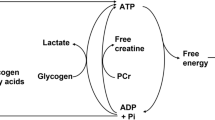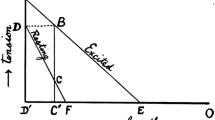Summary
-
1.
This paper concerns meaning and validity of cardio-respiratory studies of light work, that is, according to our meaning given to this term, the movements of the upper limbs which can be performed repeatedly in the absence of fatigue.
-
2.
The scope of light muscular work is defined according to three criteria: a) the muscular mass set to work must be less than a third of the whole muscular mass; b) the metabolic rate increase must not exceed its rest value by more than 250 ml/min; c) the percentage of the maximum force set to work must not go above 40 p. 100 if the static component is significant and rest pauses are not less than 50 p. 100.
-
3.
Cardio-respiratory adjustments to light muscular work presents some particular features which are discussed. From these facts we deduce that evaluating oxygen consumption from pulmonary ventilation (or heart rate) is not justified in the zone of the metabolic variations considered. The interest and meaning of these divers variables are also explained.
-
4.
The discriminative character of oxygen consumption and heart rate is analysed. Experimental designs and statistic control of the results constitute a discriminating condition which is necessary but not sufficient: specific working values rather than overall values should determine the facts obtained.
-
5.
The field in which physiological approaches are valuable within the perspective of applications to professional gestures, appears to be that of repetitive work which requires a limited visual control.
Zusammenfassung
-
1.
Die Arbeit beschäftigt sich mit der Bedeutung von Untersuchungen des Kreislaufs und der Atmung bei leichter Arbeit. Unter leichter Arbeit verstehen wir Bewegungen der oberen Gliedmaßen, die ständig wiederholt und ohne Ermüdung ausgeführt werden können.
-
2.
Der Bereich leichter Muskelarbeit wird auf Grund folgender drei Kriterien festgelegt: a) Die tätige Muskelmasse muß weniger als ein Drittel der Gesamtmuskelmasse betragen. b) Der Arbeitsumsatz darf nicht mehr als 250 ml Sauerstoff/min überschreiten. c) Die aufgebrachte Muskelkraft darf nicht mehr als 40% der Maximalkraft betragen, wenn die Tätigkeit erhebliche statische Muskelarbeit erfordert und die Pausen weniger als 50% betragen.
-
3.
Die Anpassungen der Atmung und des Kreislaufs an leichte Arbeit bieten einige besondere Gesichtspunkte, die diskutiert werden. Auf Grund dieser Tatsachen folgern wir, daß die Berechnung des O2-Verbrauchs aus dem Atemminutenvolumen (oder der Pulsfrequenz) im Bereich der erwähnten Änderungen des Energieumsatzes nicht statthaft ist. Einfluß und Bedeutung der verschiedenen Veränderungen werden erläutert.
-
4.
Die unterscheidenden Merkmale des Sauerstoffverbrauchs und der Pulsfrequenz werden analysiert. Die Untersuchungen und die statistische Auswertung der Ergebnisse erfordern eine unterscheidende Bedingung, die notwendig, aber nicht ausreichend ist: Die Berechnungen sollen mit Arbeitswerten, nicht mit Gesamtwerten durchgeführt werden.
-
5.
Das Gebiet, für welches die Anwendung physiologischer Methoden auf Bewegungen bei der Berufsarbeit wertvoll ist, scheinen sich wiederholende Arbeiten zu sein, die eine beschränkte visuelle Kontrolle erfordern.
Similar content being viewed by others
References
Andersen, K. L.: Den kardio-pulmonale funktionstilstand hos friske mennesker i relasjon til kjonn og aider. T. norske Laegeforen.3, 227–232 (1963).
Asmussen, E., andE. Poulsen: Energy expenditure in light industry. Its relation to age, sex and aerobic capacity. Comm. Dan. Nat. Assoc. for infant. paral., n °13, 13 (1963).
Åstrand, P.-O.: Experimental studies of physiological working capacity in relation to sex and age, 179 p. Copenhagen: Munksgaard 1952.
Barcroft, H., andJ. L. E. Millen: The blood flow through muscle during sustained contraction. J. Physiol. (Lond.)97, 17–31 (1939).
Barnes, R., andM. E. Mundel: A study of simultaneous symmetrical hand motions. Univ. of Iowa, Study Engng., N ° 370, Bull.17, 39 (1939).
Berggren, G., andE. H. Christensen: Heart rate and body temperature as indices of metabolic rate during work. Arbeitsphysiologie14, 255–260 (1950).
Bevegård, S.: Studies on the regulation of the circulation in man. Acta physiol. scand.57, Suppl. 200, 36 (1963).
Block, S. M.: Effects of visual requirements upon certain simultaneous hand motions. Ph. D. Thesis, Univ. of Minnesota,149 (1956).
Bouisset, S., D. Hénon etH. Monod: Influence de l'amplitude du mouvement sur le coût d'un travail musculaire. Ergonomics5, 265–270 (1962).
—, etH. Monod: Etude physiologique sur l'aménagement du plan de travail. Note préliminaire. Travail Humain22, 159–162 (1959).
— —: Etude d'un travail musculaire léger. I — Zone de moindre dépense énergétique (activité monomanuelle). Arch. int. Physiol. Bioch.70, 259–272 (1962).
— —, etD. HÉnon: Etude d'un travail musculaire léger par la mesure de la fréquence cardiaque. Travail Humain25, 51–61 (1962).
Bratton, E. C.: Oxygen consumed in household tasks. Cornell Univ. Agric. Exp. Stn., Ithaca, Bull.873, 23 (1951).
—: Some factors of cost to the body in standing to work and sitting to work under different postural conditions. Cornell. Univ. Agric. Exp. Stn. Ithaca, Mem.365, 44 (1959).
Brouha, L.: Physiology in industry, 145 p. Oxford: Pergamon Press 1960.
Caldwell, L. S.: Relative muscle loading and endurance. J. Engng. Psychol.2, 155–161 (1963).
Christensen, E. H.: Beiträge zur Physiologie schwerer körperlicher Arbeit. I.Arbeitsphysiologie4, 128–153 (1931).
—: Physiological valuation of work in Nykroppa iron works. In Symposium of fatigue, 93–108. London: Lewis and Co. 1953.
Comroe, J. H., R. E.Forster, A. B.Dubois, W. A.Brisooe, and E.Carlsen: The lung. Clinical physiology and pulmonary function tests, 219 p. Chicago: Year Book Publishers 1955.
Dejours, P.: Exercice musculaire. InKayser, Physiologie, Tome II, 1027-1075. Paris: Hammarion 1963.
Dill, D. B.: The economy of muscular exercise. Physiol. Rev.16, 263–291 (1936).
Döbeln, W. V.: Maximal oxygen intake, body size and total hemoglobin in normal man. Acta physiol. scand.38, 193–199 (1956).
Draper, J., R. G. Edwards, andR. H. Hardy: Method of estimating the respiratory cost of a task by use of minutevolume determination. J. appl. Physiol.6, 297–303 (1953).
Durnin, J. V. G. A., andR. G. Edwards: Pulmonary ventilation as an index of energy expenditure. Quart. J. exp. Physiol.40, 370–377 (1955).
Eskilson, J. E.: Effect of pace and distance on energy expenditure and body member acceleration and motion patterns for transport empty. Washington Univ., St-Louis, Master of Sci. Thesis 63 p. (1952).
Ford, A. B., andH. K. Hellerstein: Estimation of energy expenditure from pulmonary ventilation. J. appl. Physiol.14, 891–893 (1959).
Farkas, G., u.J. Geldrich: Über den Energieverbrauch bei gewerblicher Arbeit. Arch. Hyg. (Berl.)104, 1–23 (1930).
Frohse, F., u.M. FrÄnkel: Die Muskeln des menschlichen Armes. In Handb. Anatomie des Menschen,Bardeleben, II,2 B, S. 693. Jena: Fischer 1908.
Galetti, P. M.: Les échanges respiratoires pendant l'exercice musculaire. Helv. physiol. pharmacol. Acta17, 34–61 (1959).
Karpovich, P. V.: Physiology of muscular activity, 368 p. Philadelphia-London: Saunders 1959.
Kayser, Ch.: Physiologie du travail et du sport, 264 p. Paris: Hermann 1947.
Laville, A., S. Bouisset etH. Monod: Etude d'un travail musculaire léger. II — Zone de moindre dépense énergétique (activité bi-manuelle, simultanée et alternée.) Arch. int. Physiol. Bioch.71, 431–440 (1963).
—,F. Lille etH. Monod: La fréquence cardiaque au cours du travail statique intermittent. J. Physiol. (Paris)54, 363–364 (1962).
Lehmann, G.: Physiologie pratique du travail. Traduction française, 446 p. Les éditions d'organisation Paris 1955.
—,E. A. Müller u.H. Spitzer: Der Calorienbedarf bei gewerblicher Arbeit. Arbeitsphysiologie14, 166–235 (1950).
Liddell, F. D. K.: Estimation of energy expenditure from expired air. J. appl. Physiol.18, 25–29 (1963).
Lille, F., H. Abourachid, M. Phuon etH. Monod: La capacité de travail dans la contraction musculaire isométrique intermittente. J. Physiol. Paris55, 158 (1963).
McCugh, R. M.: Time and energy relationship of one and two hand activity. St-Louis: Washington Univ., Master Sci. Thesis, 44 p. (1952).
Malhotra, M. S., S. S. Ramaswamy, S. N. Ray, andT. N. Shrivastav: Minute ventilation as a measure of energy expenditure during exercice. J. appl. Physiol.17, 775–777 (1962).
Marro, F., V. Milani eE. Vigliani: Studio sul consumo energetico delle dattillografe con macchina meccanica ed elettrica. Med. d. Lavoro45, 12–28 (1954).
Monod, H., S. Bouisset etA. Laville: Etude d'un travail musculaire léger. III. Influence de la charge. Arch. int. Physiol. Bioch.71, 441–461 (1963).
- et A.Laville: Problèmes posés par la mesure de la consommation d'oxygène au cours du travail musculaire local. Travail Humain,28, in press (1965).
—,F. Lille etF. Bonde-Petersen: Coût énergétique comparé des contractions statiques et dynamiques chez l'Homme. C. R. Soc. Biol. (Paris)157, 2152–2155 (1963).
—, etJ. Scherrer: Capacité de travail statique d'un groupe synergique chez l'Homme. C. R. Soc. Biol. (Paris)151, 1358–1362 (1957).
—, etJ. Scherrer: Energétique comparée du travail dynamique et du travail statique. J. Physiol. (Paris)56, 615–616 (1964).
- - Conséquences ergonomiques de certaines données fondamentales concernant la contraction statique. Ergonomics, 8, in press (1965 a).
- - The work capacity of a synergie muscle group. Ergonomics, 8, in press (1965b).
Müller, E. A.: Occupational work capacity. Ergonomics5, 445–452 (1952).
Nichols, D. E.: Physiological evaluation of selected principles of motion economy. Univ. Microfilms, Ann. Arbor Michigan, Ph. D. Thesis, Purdue Univ., 191 p. (1958)
Orr, J. B., andI. Leitch: The determination of the calorie requirements of man. Nutr. Abstr. Rev.7, 509–529 (1938).
Passmore, R., andG. V. J. A. Durnin: Human energy expenditure. Physiol. Rev.35, 801–840 (1955).
Phuon, M.: La capacité de travail statique intermittent. Thèse Doot. Méd., Paris, 61 p. (1963).
Rohmert, W.: Ermittlung von Erholungspausen für statische Arbeit des Menschen. Int. Z. angew. Physiol.18, 123–164 (1960).
Rushmer, R. F., andO. A. Smith: Cardiac control. Physiol. Rev.39, 41–68 (1959).
Sartorelli, E.: Rapporti tra ventilazione polmonare e consumo energetico durante il lavoro. Med. d. Lavoro47, 350–355 (1956).
—, eC. Sbertoli: Misura della fatica muscolare mediante lo studio delia frequenza cardiaoa durante il lavoro. Med. d. Lavoro48, 159–164 (1957).
Scherrer, J., etH. Monod: Le travail musculaire local et la fatigue chez l'Homme. J. Physiol. (Paris)52, 419–501 (1960).
— —, etC. Soula: Appréciation de l'apport énergétique et rendement dans le travail musculaire local. Wychowanié fizyczne i sport4, 428–438 (1961).
Schreidbr, E.: La Biométrie, n ° 871, 126 p. Paris: Presses Universitaires de France 1960.
Soula, C., J. Scherrer, A. Bourguignon, C. Bourguignon, R. Moynier, etH. Monod: Aspects musculaires, sensoriels, psychologiques et sociaux de la fatique. Arch. Mal. prof.22, 419–446 (1961).
Spitzer, H., u.Th, Hettinger: Tafeln für den Kalorienumsatz körperlicher Arbeit. Sonderheft der REFA-Nachrichten, Darmstadt1, 89 (1959).
Stier, F.: Die Geschwindigkeit von Armbewegungen. Int. Z. angew. Physiol.18, 82–100 (1959).
Turner, D.: Energy cost of some industrial operation. Brit. J. industr. Med.12, 237–239 (1955).
Wells, J. G., B. Balke, andD. D. van Fossan: Lactic acid accumulation during work. A suggested standardization of work classification. J. appl. Physiol.10, 51–55 (1957).
Wilkes, J. W.: The effect of job difficulty factors on time energy and acceleration of motion patterns. Washington Univ., St. Louis, Sci. Dissert. 140 p. 1954.
Williams, M., and H. R.Lissner: Biomechanics of human motion, 147 p. Philadelphia-London: Saunders 1962.
Wolpert, H.: Über die Kohlensäure- und Wasserdampf-Ausscheidung des Menschen bei gewerblicher Arbeit und bei Ruhe. Arch. Hyg. (Berl.)26, 68–108 (1896).
Author information
Authors and Affiliations
Additional information
We are indebted to Mrs. F.Huart for her skilled technical assistance and to Miss M. C.Reymond for the statistical treatment of data.
Rights and permissions
About this article
Cite this article
Bouisset, S., Monod, H. & Pertuzon, E. The meaning and validity of cardio-respiratory studies of light muscular work. Int. Z. Angew. Physiol. Einschl. Arbeitsphysiol. 21, 74–98 (1965). https://doi.org/10.1007/BF00693390
Received:
Issue Date:
DOI: https://doi.org/10.1007/BF00693390




